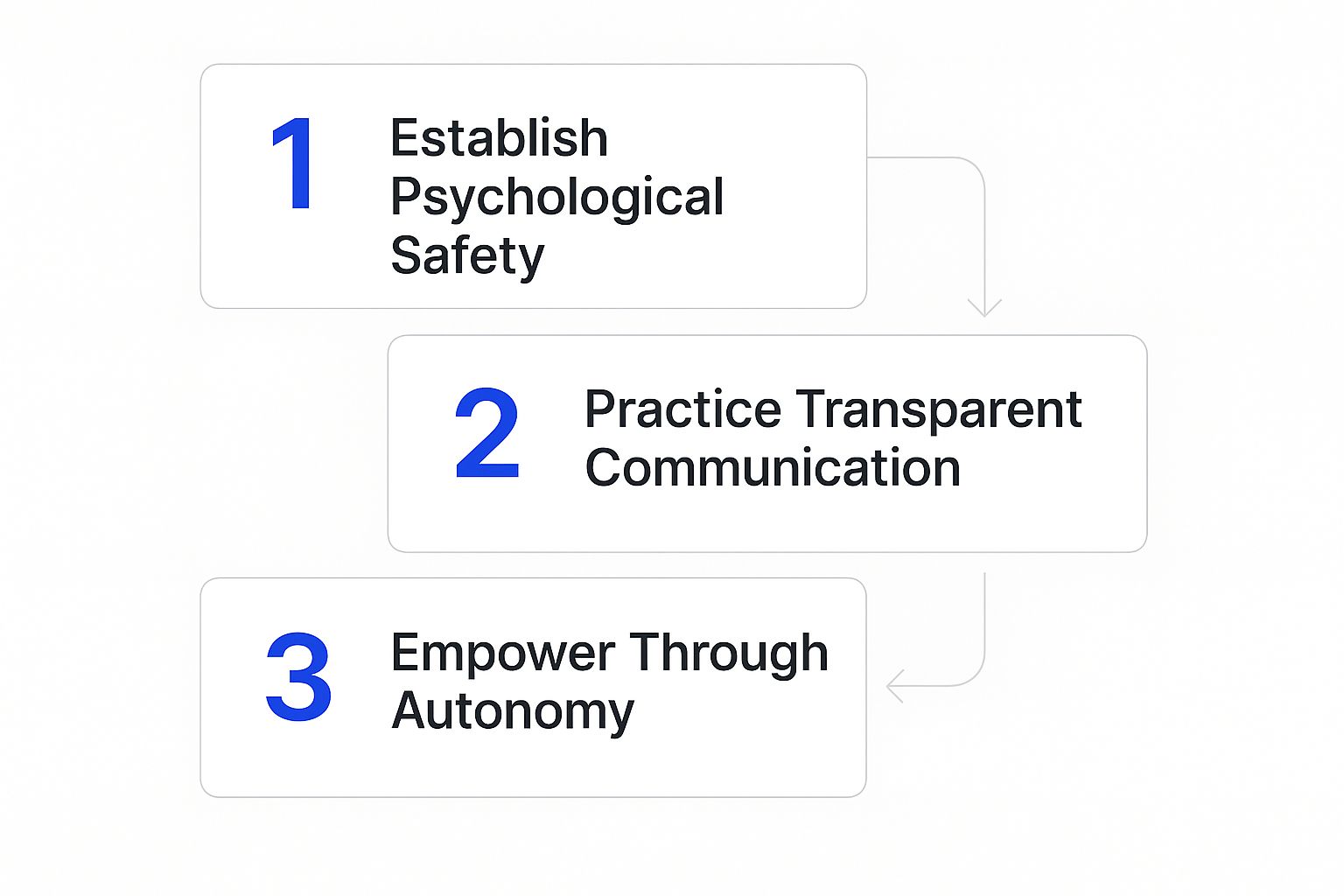Building real trust in a team isn't something that just happens. It's something you build, brick by brick, through intentional actions. Leaders have to actively cultivate an environment where people feel safe, communication is honest, and consistency is the rule, not the exception. This is how you turn a collection of individuals into a tight-knit, resilient team.
Why Team Trust Is Your Greatest Asset
Let’s get one thing straight: trust isn't a "nice-to-have" or a soft skill. It's the absolute bedrock of any high-performing team. Think of it as the invisible glue that holds everyone together, transforming tentative conversations into genuine collaboration.
When people trust their leaders and their colleagues, they feel secure enough to take risks, own up to mistakes, and even challenge the way things are done—all without fearing repercussions. This sense of psychological safety is the secret ingredient for any team that wants to do great work consistently.
This guide is about moving past the usual clichés and getting into the practicalities of how authentic trust boosts productivity, sparks new ideas, and keeps your best people around. Without it, you’re left with micromanagement, plummeting morale, and a culture where people cling to information instead of sharing it freely.
On the flip side, environments where trust is high are easy to spot. They're marked by:
- Effortless Collaboration: People are eager to work together and share what's on their mind.
- Quicker Decisions: The team can move forward confidently without constantly questioning each other's intentions.
- Stronger Resilience: A team built on trust can bounce back from challenges and adapt to change far more effectively.
This isn't just an internal phenomenon. The 2025 Edelman Trust Barometer found that UK businesses are the most trusted institution by the British public, with a 51% trust level. That trust is directly tied to how ethical and competent people perceive those businesses to be. To get the best from your team, you need to mirror those same qualities internally. You can dig into the full UK trust findings on their website.
Before we dive into the "how," it's worth getting clear on the fundamentals. The best teams are built on a few core principles that create a foundation of trust.
The Core Pillars of Team Trust
These pillars aren't just abstract ideas; they are the active ingredients you'll be using to build a more connected and effective team.
Trust is the quiet confidence team members have in each other’s integrity, character, and ability. It's the simple belief that your colleagues have your back and are all pulling in the same direction.
Ultimately, investing in trust pays real dividends. It cuts down on the friction caused by suspicion and office politics, which frees everyone up to focus on the work that matters. When you create this positive cycle, you'll find that trusted employees are more engaged, more productive, and far more likely to stick around. This is the foundation for creating building high-performance teams.
Create an Environment of Psychological Safety

Before your team can truly trust each other, they have to feel safe. We’re talking about psychological safety here—the shared belief that it’s okay to take risks within the group. It’s that feeling in your gut that tells you it’s safe to speak up with ideas, ask questions, voice concerns, or even admit you’ve made a mistake, all without fear of being shot down or humiliated.
This isn’t about being artificially nice or sidestepping tough conversations. Quite the opposite. It’s about building a culture of respect where people feel comfortable being candid and where showing a bit of vulnerability is a sign of strength, not weakness.
When people feel safe, they bring their authentic selves to work. That’s where the real magic happens—creativity flows, and collaboration becomes second nature. Without this foundation, any other trust-building exercises are just window dressing.
Model Vulnerability from the Top
Trust has to start with the leader. If you want your team to be open and honest, you have to go first. You need to show them it's not just safe, but normal, to be imperfect.
This means owning your mistakes, being comfortable saying "I don't know," and letting your team see your own learning process, warts and all.
Let's say you've just wrapped up a marketing campaign that fell flat. Instead of pointing fingers or deflecting, you could kick off the debrief by saying, “I completely misjudged the audience for this campaign, and that’s on me. Let’s dig into what went wrong so we can all learn from it.” That one sentence can instantly turn a failure into a powerful trust-building moment.
When a leader models vulnerability, they give permission for others to do the same. It sends a clear message: "Mistakes are for learning, not for blaming." This is how you build a resilient culture where people focus on solutions instead of self-preservation.
Actively Solicit and Reward Dissent
Groupthink is the silent killer of innovation. It’s also a massive red flag for low psychological safety. In teams where people are afraid to challenge the status quo, bad ideas get a free pass and brilliant ones never even see the light of day. As a leader, it’s your job to actively hunt for disagreement.
Stop asking, “Does anyone have any questions?” and start asking better ones:
- "What are we missing here?" This assumes there are gaps and invites your team to find them.
- "Who has a different perspective on this?" This makes dissent normal and frames it as a valuable contribution.
- "Let's play devil's advocate for five minutes. What's the single biggest risk with this plan?" This creates a structured, safe space to critique an idea without it feeling like a personal attack.
When someone does offer a dissenting view, how you react is everything. Thank them for their courage and insight, even if you don't end up agreeing. If a team member pokes a hole in your grand plan, fight the urge to get defensive.
Instead, try something like, “That’s an excellent point I hadn’t considered. Thank you for raising it. How do you think we could address that?” This reinforces that challenging ideas isn't just safe; it’s valued. And in doing so, you’re not just getting better outcomes; you are actively showing your team how to build trust.
Practise Transparent and Empathetic Communication

If psychological safety is the foundation of team trust, then transparent communication is the very framework you build upon it. Ambiguity is a breeding ground for mistrust. It’s just human nature—when people don’t have clear information, they tend to fill in the gaps with their own assumptions, which are often far worse than reality.
True transparency isn't just about sending out regular updates. It's about pulling back the curtain to share the "why" behind decisions, being candid about challenges, and ditching the corporate jargon that creates an emotional chasm between leaders and their teams.
Ditch the Jargon and Get Real
Corporate-speak can feel like a shield, but it often comes across as insincere or, worse, like you’re hiding something. Phrases like "leveraging synergies" or "optimising our operational workflow" mean very little to the average employee and create a barrier to genuine connection.
So, instead of hiding behind vague language, speak plainly and directly.
- Instead of: "We are recalibrating our strategic priorities to better align with market dynamics."
- Try: "Our biggest competitor just launched a new feature, so we need to shift our focus to project X for the next month to stay competitive. This means project Y will be on hold."
This direct approach shows respect for your team's intelligence and makes them feel like trusted partners in the business. It’s a simple shift that can dramatically improve clarity and help everyone see exactly how their work fits into the bigger picture.
Trust isn’t built on perfect news; it’s built on honest communication. Sharing challenges and being upfront about setbacks shows your team you see them as adults who can handle the truth, which is a powerful way to foster loyalty and respect.
Poor communication is a significant trust-killer. Recent UK workplace research highlights that 43% of on-site employees lose trust in leadership due to it, and only a mere 13% feel their management communicates effectively. This disconnect is a major obstacle to building the kind of cohesive, high-performing team you need.
Make Listening Your Superpower
Communication is a two-way street, and listening is arguably the more important direction. Active listening isn't just about staying quiet while someone else talks; it's about making them feel genuinely heard and understood. This means being fully present, which is a real challenge in our distraction-filled hybrid work environments.
Here are a few practical ways to become a more empathetic listener:
- Paraphrase and Clarify: When a team member shares a concern, repeat it back to them in your own words. "So, if I'm understanding correctly, you're worried that the new deadline is unrealistic because we haven't accounted for potential delays in testing?" This shows you're paying attention and ensures you’re both on the same page.
- Ask Open-Ended Questions: Avoid simple yes/no questions. Instead, use questions that encourage deeper thought, like "How are you feeling about this change?" or "What support do you need to make this happen?"
- Acknowledge the Emotion: Sometimes, people just need to feel validated. A simple "I can see why you're frustrated" or "That sounds like a really challenging situation" can defuse tension and build a strong emotional connection. It shows empathy—a critical tool for any leader.
This level of attentive communication is also essential when delivering feedback. You can explore our complete guide on how to give constructive feedback to master this skill.
Lead by Example with Consistency and Accountability

Your team is always watching. They pay far more attention to what you do than what you say. Trust isn't built on grand speeches or carefully crafted mission statements; it’s earned in the small, everyday moments through unwavering consistency.
When your actions align with your words, you create a stable, predictable environment. That predictability is the bedrock of trust. It reassures your team that the goalposts aren't going to shift based on your mood and that standards are applied fairly to everyone, every time.
Follow Through on Every Single Commitment
Every promise you make is a test of your reliability, no matter how small it seems. Saying you’ll review a document by the end of the day and then actually doing it? That’s a small deposit in the trust bank.
On the flip side, consistently missing those little deadlines creates tiny cracks in your credibility. Over time, those cracks can become chasms. To really foster trust, you have to be someone who honours their word.
- Protect your calendar. If you commit to a one-on-one, show up on time and be fully present. No distractions.
- Track your promises. Use a simple task manager to note down commitments you make in meetings or emails so nothing falls through the cracks.
- Communicate delays proactively. If you know you're going to miss a deadline, get ahead of it. Explain why, and don't wait for someone to chase you.
This level of follow-through isn't just about getting things done; it's a powerful signal of respect for your team's time and effort. It shows them you're dependable, which makes it safe for them to depend on you.
Own Your Mistakes – Publicly and Without Excuses
Nothing evaporates trust faster than a leader who deflects blame. When things go wrong, the natural instinct can be to find an external reason or, worse, a scapegoat. A truly trustworthy leader fights that urge and steps up to take ownership.
Picture this: a project misses a crucial deadline. The blame-shifting leader might say, "Well, the marketing team was late with their input."
But the accountable leader says, "I mismanaged the timeline here and didn't build in enough of a buffer for cross-team dependencies. That's on me, and here's my plan to fix it." See the difference?
Taking public responsibility for a failure doesn't make you look weak; it makes you look human and strong. It shows your team that mistakes are for learning, not for blaming, which reinforces the psychological safety they need to do their best work.
This simple act transforms a negative moment into a powerful lesson in integrity. It proves you hold yourself to the exact same standard you expect from everyone else. This is especially vital in the UK, where leadership trust can be a delicate issue. In fact, broader UK statistics suggest only about 64% of employees feel their leaders show that people are important to company success. You can explore more insights on the state of UK workplace trust at Great Place to Work®.
In the end, consistency and accountability are two sides of the same coin. By keeping your promises, applying standards fairly, and owning your missteps, you become a reliable anchor for your team. That’s how you build trust that truly lasts.
Give Your Team Autonomy (and the Support to Match)
If you want to kill trust fast, just start micromanaging. It’s the quickest way to tell someone, "I don't actually believe you can do your job without me watching your every move." Building real, lasting trust means you have to deliberately step back from being a director and step up as a coach.
This is all about handing over genuine ownership. Don't just delegate a list of tasks; delegate an outcome. When you give someone responsibility for an entire project, from the initial idea to the final delivery, you’re not just giving them work. You’re showing them you trust their judgement, their skills, and their commitment. This simple shift turns them from a task-doer into a strategic owner, and that’s a game-changer for engagement.
Of course, this isn't about throwing your team in at the deep end and hoping for the best. Empowerment without support is just abandonment. Your job is to make sure they have the authority, the budget, and the information they need to get the job done. Then, you step back and make it clear you’re there for guidance, not to snatch the reins at the first wobble.
Reframe Failure as a Learning Opportunity
You can't have a culture of autonomy if everyone is terrified of making a mistake. It just won't work. If your team members are constantly worried about getting things wrong, they’ll never take the smart, calculated risks that lead to breakthroughs. Instead, they’ll play it safe, ask for permission for every tiny decision, and all that creative energy will just fizzle out.
Your job is to actively reframe failure as just another part of the learning process. When a project hits a snag or doesn't deliver the expected results, your reaction sets the tone for the entire team. Ditch the blame game and instead lead a constructive conversation about what happened.
Try asking questions like:
- What was our original theory here, and what did we actually learn?
- Knowing what we know now, what would we do differently next time?
- What roadblocks did we hit that we didn't see coming?
By treating setbacks as valuable data rather than disasters, you build psychological safety. You create an environment where people feel secure enough to experiment, push boundaries, and ultimately grow. That’s how you build trust through genuine support.
True empowerment is giving your team the freedom to succeed and the safety to fail. When you show you trust their judgment even when things go wrong, their loyalty and commitment will skyrocket.
From Director to Coach: Making the Shift
Pivoting your leadership style takes a conscious effort. It’s less about giving orders and more about asking insightful questions. If you want to go deeper, our guide on how to delegate tasks effectively has more detailed strategies. For now, here’s a quick look at how to adjust your approach:
Making this transition doesn't just feel better; it shows your team you believe in their potential. In return, they'll become more invested, more reliable, and more committed to helping everyone succeed.
Putting It All Into Practice
So, how do we make all of this a reality? The key is to weave these strategies into your team's daily rhythm. Building trust isn't a one-off initiative you can tick off a list; it’s a constant, deliberate effort. Your goal should be to make psychological safety, open dialogue, and real empowerment the bedrock of how your team operates.
This infographic breaks down the essential sequence for laying that foundation.

The logic here is straightforward. When people feel safe, they're more willing to communicate openly. And when communication is flowing, you can confidently empower them with genuine autonomy. Each stage naturally leads to the next.
Start with Small, Consistent Actions
If you want to get started right away, focus on a few high-impact behaviours you can try this week.
- Lead with vulnerability. Next time you're in a team meeting, be the first to admit a small mistake you made or something you're unsure about. It sets a powerful precedent.
- Practise active listening. In your next one-on-one, instead of jumping to solutions, simply paraphrase your team member's concern back to them to show you've truly heard and understood.
- Delegate an outcome, not a task. Give someone on your team full ownership of a small project. Clearly define the goal you want them to achieve, but let them figure out the "how."
A high-trust culture is built on the accumulation of small, everyday moments. When you consistently show up in these ways, you demonstrate that you're a reliable, fair, and supportive leader.
Ultimately, this is more than just good management—it's a serious competitive edge. A team built on trust is more innovative, more resilient, and creates a culture where your top talent wants to stick around and deliver their best work.
Have Questions About Building Team Trust? We've Got Answers
When leaders start getting serious about building trust, the same questions tend to pop up. Let's tackle some of the most common ones I hear from managers navigating this.
How Quickly Can I Actually Build Trust in a New Team?
Look, trust doesn't just appear overnight. But you can definitely put your foot on the accelerator. It all starts with being deliberate and consistent from the moment you meet your team.
Your first job is to create clarity. Make sure everyone knows exactly what's expected of them and how you'll all communicate. No grey areas. Then, you have to lead by example. Be the first to admit when you don't have an answer. Most importantly, if you say you're going to do something, do it. Every single time.
A great way to get some early momentum is to find a quick, visible win. Was there a small, annoying issue the team was dealing with before you arrived? Fix it. It shows you're listening and you're there to help them succeed.
What's the Fastest Way to Completely Wreck Team Trust?
Want to torpedo trust? Be inconsistent. Nothing destroys confidence faster than a leader who says one thing and does another. It creates a culture of second-guessing and uncertainty.
Some specific behaviours are absolute trust-killers:
- Passing off your team's hard work as your own.
- Playing politics by saying different things to different people.
- Picking favourites and making it obvious.
- Throwing your team under the bus to cover your own mistakes.
These actions breed cynicism and fear, and once that toxic environment takes hold, it's incredibly tough to fix.
Rebuilding broken trust is a monumental task—far harder than earning it in the first place. Your best bet is always prevention through consistent, principled leadership.
How Can We Rebuild Trust Once It's Been Broken?
Okay, so the damage is done. Rebuilding is possible, but it demands humility, a clear plan, and a lot of patience.
First, you have to own the mistake. Acknowledge what happened, out in the open, and give a genuine apology without any "buts" or excuses. Next, lay out the specific actions you'll take to ensure it never happens again.
And then comes the hard part: you have to consistently follow through, over time. Your actions will always shout louder than your apologies ever could.

